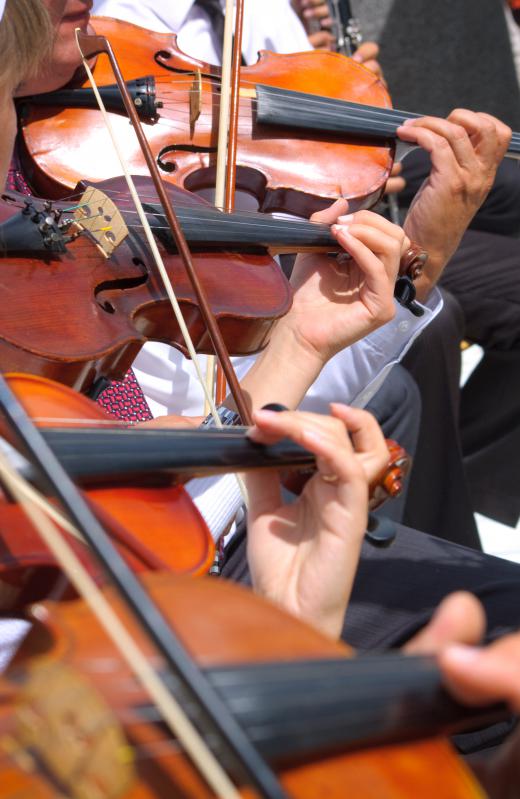At MusicalExpert, we're committed to delivering accurate, trustworthy information. Our expert-authored content is rigorously fact-checked and sourced from credible authorities. Discover how we uphold the highest standards in providing you with reliable knowledge.
What Is a Philharmonic Orchestra?
A philharmonic orchestra is a large group of musicians who perform instrumental music. This type of musical ensemble includes brass, string, woodwind, and percussion instruments and can have more than 100 musicians, though they are not all necessarily present at every performance. It is distinguished from a chamber orchestra, a smaller ensemble with 50 musicians or less. Philharmonic orchestras primarily play classical music, though today many can also be heard in other areas, such as film scores, popular music, and music for video games.
Originally, a philharmonic orchestra referred to an orchestra created by a philharmonic society. The societies, who took their name from classical Greek words meaning “lovers of harmony,” were made up of musicians and other lovers of music who organized orchestras to perform music for the general public. This distinguished a philharmonic orchestra from other orchestras of the time, which were primarily created and supported by the patronage of kings and other aristocrats. Over time, the term has become increasingly divorced from its origins and is now frequently used as a generic term for a full orchestra, used interchangeably with symphony orchestra. It is often used when a city has more than one major orchestra in order to differentiate them.

A modern philharmonic orchestra has a diverse array of instruments. An orchestra's string section contains bowed string instruments such as the violin, cello, and double bass, as well as the harp. The string section is by far the largest part of the orchestra. The woodwinds include flutes, bassoons, and clarinets. The brass section contains horns such as the trumpet, trombone, and tuba.

Percussion can be much more variable, according to the particular music being played, but can contain cymbals, different types of drums, and percussion instruments played with mallets such as the xylophone, vibraphone, and glockenspiel. In addition to the four main sections, an orchestra may also incorporate additional instruments, such as the piano and classical guitar. The different musicians and sections are coordinated by the orchestra's conductor, who stands in front of the musicians and uses gestures to indicate the proper beat and tempo, cue different musicians to begin playing, or indicate changes in volume.

The first philharmonic society began in London in 1813. The oldest, still in existence today, is the Royal Liverpool Philharmonic, founded in 1840. In modern times, philharmonic orchestras are common throughout the world. Prestigious examples operating today include the Vienna Philharmonic in Austria, the Berlin Philharmonic in Germany, and the New York Philharmonic in the United States.
AS FEATURED ON:
AS FEATURED ON:














Discussion Comments
I won free tickets to one of our local symphony orchestra concerts. I have lived in this city most of my adult life, and had never been to hear the orchestra.
Since I had free tickets, I didn't want to miss out so was looking forward to the evening. I really didn't know what to expect, and wondered if I might get a little bored during the performances.
It turned out to be a great evening and I didn't have to worry about being bored. The music was professional and upbeat. I enjoyed the faster songs the best, but liked the sound of all the different instruments playing at the same time.
After leaving the concert, I had a new appreciation for this kind of music and the hard work that goes in to something like this.
While I am not very musically talented, I love listening to a good orchestra play. The sounds of a philharmonic orchestra are so rich and diverse.
Every year around the holidays I get the chance to hear a Christmas concert by a philharmonic orchestra and always look forward to the evening.
I enjoy all the instruments, but have always been particularly interested in the percussion. There are so many percussion instruments that really help set the tempo and add wonderful special effects to the songs.
I know it takes hours of rehearsal time for the musicians to perform their concert. The two hours of music flies by too fast, but I always leave feeling upbeat and in the holiday spirit.
There is nothing as impressive is a philharmonic orchestra performing epic songs from movies. While there is a lot to be said for purely classical music, I love how many orchestras have branched out to creating new and more modern music. I think it really helps them to reach a wider audience and attract those that are younger.
One of the best shows I have ever seen is a philharmonic orchestra playing pieces from The Lord of the Rings soundtrack. I love how truly intense the music was and how it brought back memories from the books and movies I loved. There is nothing like having music take you through a familiar story.
For a great evening out getting tickets to your local philharmonic orchestra can be a treat. I feel that because not a lot of people frequent classical music halls these days tickets can often be gotten quite cheaply outside of a few prime time slots.
There are even times when you can find tickets to a philharmonic orchestra for free. This can happen during festivals and holidays.
I remember a few winters ago when our local philharmonic orchestra put on a Christmas eve show for the public. It was free and an amazing experience for everyone that attended. Not only did the orchestra play a lot of holiday favorite but they gave us a sampling of a few of the songs they would be performing during the regular season.
Post your comments